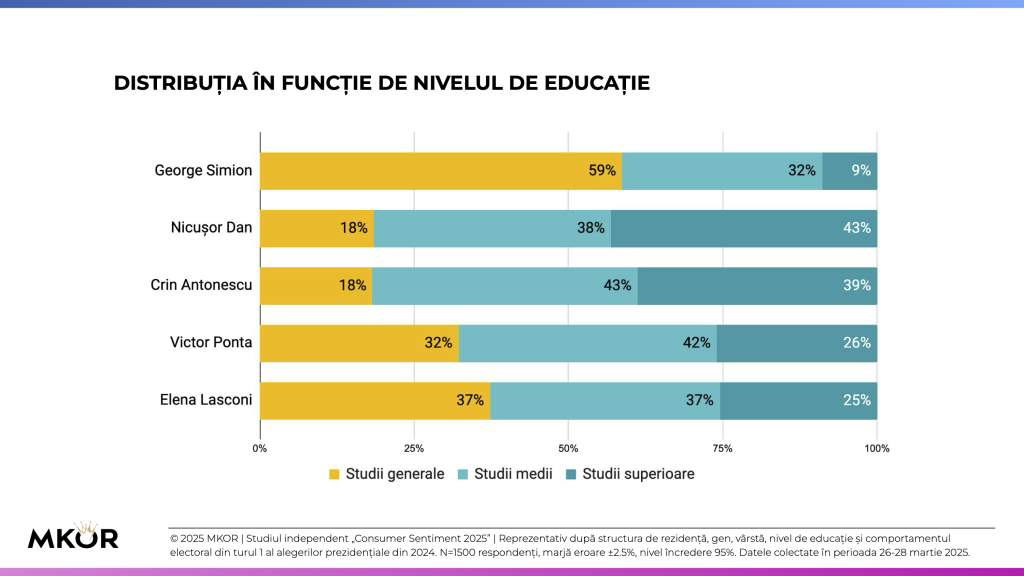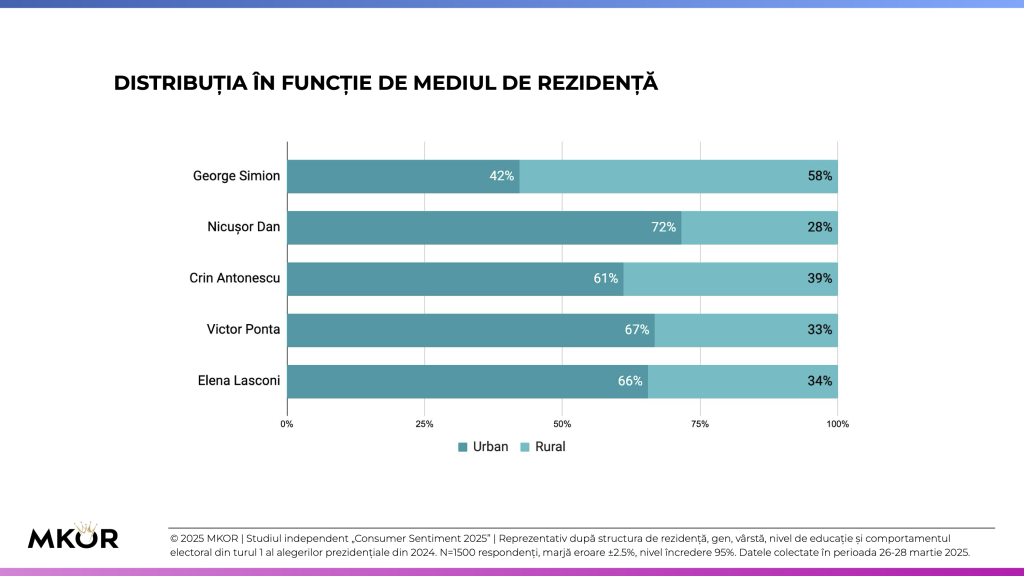In 2025, Romanians Go to the Polls Without Knowing Who They Will Vote For
The 2025 presidential elections are shaping up to be among the most unpredictable in recent years. Voting intentions are fragmented: over 45% of Romanians aged 18 to 65 cannot spontaneously indicate a candidate they would vote for in the May presidential elections, and the projected results for the second round are on the edge. In this polarized electoral landscape, abstention and indecision could radically change the final outcome.
In a climate dominated by distrust and a lack of clear options, MKOR conducted an independent study to understand who the real voters of Romania are and what mechanisms drive their voting intentions.
Content
Why We Conducted This Study
At MKOR, we believe that understanding social reality must begin with objective data, collected independently and analyzed without bias.
We wanted to truly understand the intentions and motivations of the Romanian electorate—through our own lens, without being influenced by political parties, institutions, or commercial interests.
This research was carried out 100% independently, exclusively at MKOR’s initiative, as part of our ongoing mission to provide relevant and honest insights into Romanian society.
The data we present was not commissioned, financed, or influenced by any political or institutional actor.
Cori Cimpoca – MKOR Founder
George Simion Leads in the First Round but Fails to Consolidate a Majority
George Simion ranks first in voting intentions for the first round of the 2025 presidential elections. In raw preference, 22.4% of respondents say they would vote for him, and his score rises to 31.2% after redistributing valid votes—excluding undecideds, blank ballots, and non-responses.

This positioning places him as the frontrunner at the start of the presidential race, with a visible advantage over the other competitors: Nicușor Dan obtains 16.2% in raw preference (22.7% redistributed), Crin Antonescu 13.5% (18.8% redistributed), Victor Ponta 12.2% (17.1% redistributed), while Elena Lasconi remains at a lower level, with only 3.8% (5.3% redistributed).
However, this score does not translate into a political or electoral majority. More than 27% of respondents express a negative or uncertain position: 16.2% are undecided, 5.9% state they would cast a blank or null vote, and 5.3% say they would not vote at all.
This electoral context suggests that the final outcome of the elections will not depend only on the first-round scores, but also on the candidates’ ability to mobilize undecided voters and reduce abstention in the second round.

When Voters Don’t Know Who They Will Vote For: 45% Cannot Spontaneously Name a Candidate
The high level of uncertainty in Romania’s electoral landscape is confirmed by the answers to the open-ended question asked at the beginning of the study: “Who would you vote for?”
Without being presented with a list of candidates, 45.3% of respondents could not name anyone or refused to answer.

This lack of spontaneous choice reflects a high level of indecision and political disengagement, indicating that a large portion of the electorate has no preferred candidate or is not sufficiently motivated to make a clear decision.
Among those who spontaneously mentioned a name, Nicușor Dan leads with 11.9%, followed by George Simion (9.8%), Crin Antonescu (8.4%), and Victor Ponta (8.3%).
Surprisingly, a significant share of respondents (7.6%) indicated Călin Georgescu—a candidate not officially on the ballot but still present in the electorate’s perception.
These results highlight not only the fragmentation of the electorate but also the difficulty candidates face in building visibility and trust beyond their core base of supporters.
They also suggest that part of the first-round vote could be decided in the final stretch, through mobilization campaigns and by winning over undecided voters.
Round 2: Elections Impossible to Predict. Simion Loses to His Main Opponents
If the second round of the presidential elections were held this Sunday, the poll data would reveal an extremely tense and unpredictable scenario.
Although clearly in the lead in the first round, George Simion loses in all second-round simulations against his main challengers.
In the scenario of a duel with Nicușor Dan, the electorate is almost evenly divided, but Nicușor Dan manages to secure a narrow margin: 35% for Nicușor Dan versus 31% for George Simion. The difference comes mainly from Nicușor Dan’s ability to mobilize the urban and educated electorate, as well as from undecided voters in the first round.
In a contest with Crin Antonescu, the results are similar: 33% for Antonescu and 31% for Simion. Likewise, in the case of a duel with Victor Ponta, the scores are tied at 30% – 30%, confirming the high level of uncertainty.
In a close race in which George Simion faces Elena Lasconi, 31% of Romanians would support Simion, while Lasconi would obtain 30%. Again, this scenario does not guarantee the victory of the AUR candidate.
A common feature of all these scenarios is the extremely high level of undecided voters, blank ballots, and non-participation. Over 35% of respondents declare that they would cast a blank or null vote, would not go to the polls, or remain undecided. This latent but uncertain electoral base could decisively tip the balance of the elections, while also risking an increase in abstention and electoral volatility.
The second-round results confirm a key issue: although George Simion leads clearly in the first round, he does not succeed in consolidating a majority and remains vulnerable in a polarized electoral climate, marked by a high level of indecision.

Romania’s Electorate, Divided into Two Worlds: Urban vs. Rural, Education vs. Revolt
The MKOR study reveals a sharp socio-demographic polarization between the supporters of the main candidates in the 2025 presidential elections. The Romanian electorate is divided into two distinct worlds, defined by place of residence, level of education, and socio-economic status.
George Simion benefits from a homogeneous and predictable core of supporters from a socio-demographic perspective:
- 58% of his voters come from rural areas,
- 50% declare low incomes,
- 59% have only general education,
- and 44% are inactive persons.
The dominant motivation of his supporters is the desire for change and anti-system sentiment (32%), reflecting a choice that is more reactive than proactive.


In contrast, Nicușor Dan attracts an urban, educated electorate with above-average incomes:
- 72% of his voters live in urban areas,
- 72% declare medium or high incomes,
- 43% have higher education.
The motivations of this electorate are concentrated around the candidate’s integrity and personality (44%), while the desire for change carries a more reformist than radical connotation.
Crin Antonescu and Victor Ponta mobilize a more balanced electorate, evenly distributed between urban and rural, with medium incomes and an average level of education. Their supporters primarily invoke experience and competence (36% for Ponta and 12% for Antonescu), but they also benefit from a traditional electorate, with affinities for the classic parties.
Elena Lasconi has a socio-demographic profile close to that of Nicușor Dan, but her support is more limited. Her voters mainly emphasize orientation toward values (47%), and her presence in the second round could activate a more symbolic vote, rather than a pragmatic one.
This socio-demographic polarization reflects two electoral Romanias:
- an urban one, educated, with above-average incomes, oriented toward integrity and stability,
- and a rural one, with lower incomes, general education, motivated by revolt and distrust in the system.
In this context, the 2025 presidential elections are no longer just a democratic exercise, but a real struggle between two different socio-economic and cultural models of Romania.

Who Goes to Vote? High Participation, but with the Risk of Abstention
The MKOR study data indicate a high level of declared mobilization among the supporters of the four main candidates in the 2025 presidential elections. Reported voting intention reaches high levels, signaling strong electoral interest:
- 94% of Nicușor Dan’s supporters say they will certainly vote (scores of 8–10 on a scale from 0 to 10),
- 87% of George Simion’s voters say the same,
- 86% of Crin Antonescu’s voters say the same,
- and for Victor Ponta, the percentage is 85%.
These figures suggest the presence of strongly motivated electoral bases, with only marginal differences in determination to turn out at the polls.
However, the risk of abstention cannot be ignored. In all second-round scenarios analyzed, between 35% and 45% of respondents declare that they would cast a null vote, not go to the polls, or are undecided—a warning sign that actual electoral participation could be significantly lower than declared intentions.
Against the backdrop of a tense campaign and pronounced socio-economic polarization, the behavior of undecided or demobilized voters will be crucial for the final result. Undecided voters tend to be disappointed with the candidates on offer and to express themselves through non-participation, null votes, or abstention, rather than by identifying with a candidate they trust.

Romania in 2025: A Polarized and Uncertain Electorate
The socio-demographic profile of the Romanian electorate in 2025 confirms a deeply polarized and fragmented landscape. Data from the MKOR study show that support for the main candidates is not evenly distributed across society, but instead follows key lines of differentiation: income, education, and place of residence.
George Simion attracts a predominantly vulnerable electorate, consisting especially of individuals with low income (50%), general education (59%), and residents of rural areas (58%). Nearly half of his voters are professionally inactive (44%); their main reason for supporting him is the desire for change and protest against the system (32%).
On the other hand, Nicușor Dan’s electorate has a largely urban profile (72%), with medium and high incomes (72%) and a higher level of education—43% of voters hold higher education degrees. Nicușor Dan’s supporters primarily value his personality and integrity (44%) and are, for the most part, employees (49%) or managers (10%).
Victor Ponta manages to attract a more balanced electorate from a socio-demographic perspective, with greater support among urban voters (67%), medium-income individuals (56%), and those with higher education (42%). His supporters primarily value his competence and experience (36%).
Despite the clearly defined profiles of each candidate’s electorate, more than 27% of respondents do not express a firm electoral preference. 16% declare themselves undecided, 5.9% say they would not vote at all, while 5.3% claim they will not participate. This critical mass of undecided and disenchanted voters has the potential to tilt the balance in a close and tense race.
Against the backdrop of socio-economic polarization and disappointment with the current electoral offer, the election of Romania’s future president is unfolding in a context marked by uncertainty and fragmentation.
Key Conclusions and Insights
The MKOR study outlines a complex and tense electoral landscape, in which voting intention is not merely an expression of political preferences but also a faithful reflection of Romania’s socio-economic divides.
The 2025 electoral Romania appears as a country split between two worlds, rural and urban, poverty and prosperity, education and anti-system revolt. The future president will not be chosen solely based on political programs, but rather on these profound social divisions, which are becoming increasingly visible.
Voter turnout is declared to be high, yet the risks of absenteeism and vote fragmentation remain significant, especially in the second round.
How We Conducted the Research
For this research, we ensured that the collected data reflected as faithfully as possible the social and electoral reality of Romania. Data were weighted to approximate the characteristics of voters and the results of the first round of the 2024 presidential elections.
We benefited from the expertise of Professor Mircea Comșa, to whom we extend our gratitude for his support in the process of data weighting and validation.
With over 25 years of experience in social and electoral research, his involvement was essential in ensuring the study’s solid methodological and statistical foundation.
- Sample size: 1500
- Sample characteristics: nationally representative by region, gender, age, education, and electoral behavior in the first round of the 2024 presidential elections
- Target group: Romania’s adult population, aged 18 to 65
- Method of data collection: online survey (CAWI)
- Research instrument: questionnaire
- Fieldwork: conducted by the MKOR Panel
- Period: 26–28 March 2025
We thank those who have featured our research!
The study has been received with interest by the Romanian press. Among the publications that have written about this research are:
Deutsche Welle: Analiză: Aproape jumătate dintre români nu au cu cine vota
Who We Are
At MKOR, we believe that democracy begins with real and transparent data. We trust in the power of reliable data and statistically validated insights, especially when it comes to society, behavior, and electoral decisions. Our mission is to provide a clear and objective picture of social and consumer phenomena, so you can make informed decisions.
This study on voting intentions in the 2025 presidential elections is part of our independent research initiative, carried out without political or partisan funding. Our goal is to contribute to a better understanding of Romania’s socio-political reality, beyond media or electoral filters.
If you want to better understand the market, the public, or the social context in which you operate, we can design a personalized study for you. Our Agile Research service helps you obtain relevant insights, quickly and with an optimized budget.
Through Agile Research, you can address essential questions to a nationally representative sample and receive concrete answers in a short timeframe. Whether you want to understand consumers, the electorate, or public opinion, we provide the right tools for strategic decision-making.
If you would like to learn more, we invite you to contact us or explore further details on our agile research service.
Have you read everything? Comment / join our newsletter / read our other research posts!
MKOR Survey: Romania Votes for Its Future in the Second Round of the 2025 Presidential Elections
September 11, 2025
0 Comments28 Minutes








